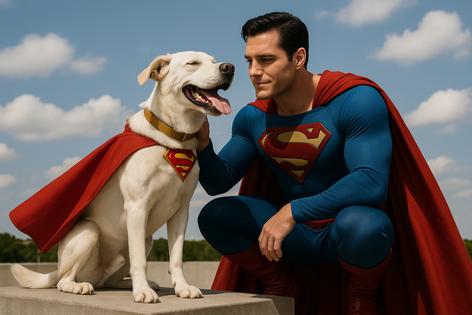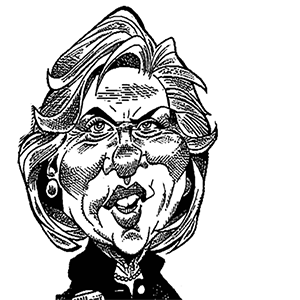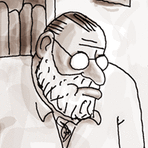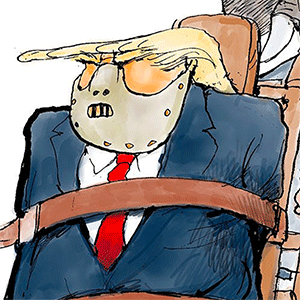Krypto's legacy is everyone's super dog
Published in Cats & Dogs News
Few characters in the Superman mythos carry as much emotional resonance as Krypto the Superdog. Introduced in the Silver Age of comics, Krypto has been everything from a whimsical sidekick to a deeply symbolic anchor of Superman's heritage. As a superpowered canine from Krypton, Krypto’s story has consistently paralleled the Last Son of Krypton's own journey. He embodies innocence, loyalty, and the grounding presence of unconditional love—traits that humanize Superman more than nearly any other figure. But more than a mere pet, Krypto represents Superman’s past, his capacity for attachment, and the increasingly complex ways comics explore family. This article traces Krypto’s evolution across decades of comics, animation, and film, while unpacking how Superman’s character has fundamentally shaped his loyal hound.
I. Origins in the Silver Age
Krypto the Superdog first appeared in Adventure Comics #210 in March 1955, created by writer Otto Binder and artist Curt Swan. The Silver Age was a time of imaginative expansion for DC Comics, marked by an embrace of science fiction and youthful sidekicks. Superboy—Superman’s younger self—was already an established presence, and DC’s editorial direction leaned into broadening the Superman family. Krypto, as a superpowered dog, fit this trend perfectly.
In his original origin, Krypto was used by Jor-El as a test subject to determine if a rocket could survive the journey from Krypton to Earth. The dog’s rocket was knocked off course, but he eventually landed on Earth and reunited with Superboy. Much like Superman, Krypto gained incredible powers under Earth’s yellow sun—super strength, flight, heat vision, and more. But he also exhibited typical dog behaviors, leading to both comedic and chaotic moments. Whether chasing cars at superspeed or digging holes to the center of the Earth, Krypto was a humorous yet heartfelt addition to the mythology.
Krypto quickly became a staple in Superboy stories. Readers adored the concept of a super dog who would fight crime, fly through the sky, and protect his master with fierce devotion. Importantly, Krypto wasn’t just a novelty—he symbolized a familial connection to Krypton. At a time when Superman’s alien heritage was often emphasized as tragic and isolating, Krypto served as a rare remnant of home.
II. Part of the Super-Family
During the late 1950s and 1960s, the Superman mythos became increasingly baroque. Supergirl, the Legion of Super-Heroes, and the Fortress of Solitude all emerged during this era. Krypto’s role also expanded. He joined the Legion of Super-Pets, a team that included Streaky the Supercat, Comet the Super-Horse, and Beppo the Super-Monkey. These stories, often whimsical and deeply strange by modern standards, emphasized Krypto’s intelligence and heroism. He was depicted as understanding human language, planning missions, and even wearing disguises (like glasses) to protect his identity.
At times, Krypto was as heroic as his human counterpart. He saved lives, battled villains, and soared through space. Yet he never lost his playful nature. His duality—a Kryptonian powerhouse with a dog’s instincts—became a beloved feature. This balance also deepened the emotional connection between him and Superboy. Unlike the Fortress’s cold architecture or the bottling of Kandor, Krypto was warm, alive, and loving. He grounded Superboy in ways even Ma and Pa Kent could not.
III. Crisis and the Age of Realism
As comics matured in the 1980s, especially with the Crisis on Infinite Earths event in 1985–86, DC sought to streamline its continuity and inject realism into its stories. Krypto did not survive this transition. John Byrne’s The Man of Steel reboot of Superman in 1986 eliminated most of the Silver Age baggage. Superman was now the lone Kryptonian survivor, and a superpowered dog no longer fit the thematic tone.
While Krypto was erased from continuity, he lived on in the hearts of fans. Writers occasionally referenced him—either as an imaginary or alternate-universe figure. For example, in Superman v2 #156 (2001), Superman is shown a perfect world created by the alien entity known as the "For the Man Who Has Everything" motif, and Krypto appears in this fantasy vision. These echoes emphasized what had been lost: not just a pet, but a piece of Superman’s emotional landscape.
Krypto’s absence for nearly two decades reveals how editorial philosophy shaped Superman’s world. The desire for realism and psychological complexity rendered the idea of a flying super dog untenable. Yet the underlying emotional truth of Krypto—that Superman needed connection and loyalty—remained compelling.
IV. The Return of Krypto
In 2001, under the writing of Jeph Loeb and the pencils of Ed McGuinness, Krypto was reintroduced in Superman v2 #170. This new Krypto was more grounded in tone. He was a white dog who had traveled from Krypton and was fiercely loyal to Superman. The design was simplified—he resembled a large, powerful Labrador with a red cape. Yet his narrative function was unchanged: Krypto was love without condition.
This version of Krypto played a pivotal role during the early 2000s. In Superman/Batman, he defends Superman’s body against Supergirl’s captors. In Infinite Crisis, he famously attacks Superboy-Prime with devastating force to protect the Kent family. These moments emphasized his power, but more importantly, they framed him as a protector of Superman’s humanity.
Krypto’s reappearance was not nostalgia—it was restoration. Writers were reclaiming the emotional weight that had been sacrificed in the name of realism. As Superman’s stories became more nuanced and centered around themes of identity, parenthood, and legacy, Krypto offered something vital: a reminder of Clark Kent’s emotional core.
V. Krypto Across Media
Krypto’s reach expanded far beyond comics. In 2005, he starred in his own animated series: Krypto the Superdog. Aimed at children, the show emphasized adventure, kindness, and teamwork. Krypto could talk (voiced by Samuel Vincent) and was portrayed as noble, brave, and selfless. Though light in tone, the series maintained the essence of the character.
More mature portrayals followed. Krypto appears in Young Justice, where he is a genetically engineered hound from Cadmus who bonds with Conner Kent. In Titans, he is a powerful, silent companion to Superboy. These appearances explore Krypto as more than a mascot—they position him as a thematic counterweight to the often-isolated Super family.
In 2022, the film DC League of Super-Pets brought Krypto to theatrical audiences, voiced by Dwayne Johnson. Here, Krypto was not only Superman’s best friend but his emotional equal. The story dealt with jealousy, independence, and the fear of abandonment. While comedic, the film’s heart was Krypto’s need to find his own identity. He learned to trust others and let Superman be loved by someone else. This arc deepened the emotional resonance of their bond.
VI. The Superman Effect: How Kal-El Shapes Krypto
Krypto is not a character independent of Superman—he is defined by him. His behavior, moral compass, and narrative utility are all reflections of Clark’s journey. As Superman evolves from alien outsider to global icon, Krypto evolves from silly pet to emotional cornerstone.
Their relationship mirrors that of a parent and child, or soldier and companion. Krypto is fiercely protective, often taking on danger that threatens Superman’s loved ones. He is also Superman’s last living link to Krypton, one not filtered through technology or memory. In that way, Krypto embodies Superman’s vulnerability. Loving Krypto means accepting loss.
Moreover, Krypto helps Superman express emotional range. Superman rarely shows grief, confusion, or anxiety publicly—but with Krypto, he can. Their bond creates narrative permission for Clark to be soft, hurt, and uncertain. Krypto offers emotional authenticity.
VII. Loyalty as a Theme
Krypto’s primary trait is loyalty, and through this, he models Superman’s own ideals. He defends the innocent, risks his life for others, and shows up—every time. Whether comforting a grieving Superboy or shielding Martha Kent from a villain, Krypto acts without hesitation.
He also teaches other characters. In Superman: Up in the Sky by Tom King, Superman travels across the galaxy to rescue a kidnapped child. Krypto joins him, uninvited, sharing the journey without complaint. The story is sparse but powerful: Krypto follows Superman not because he was asked, but because that’s what love does.
Krypto’s presence allows writers to explore Superman’s softer virtues—faith, loyalty, compassion—in ways that do not feel didactic. A dog, after all, has no ideology. He only has love.
VIII. Endurance and Legacy
Why has Krypto survived when so many other elements of the Silver Age have not? The answer lies in the timelessness of his role. Pets transcend genre. The bond between person and animal is immediate, primal, and poignant. In a world of alien invasions and multiversal collapse, a dog’s loyalty is refreshingly human.
Krypto has appeared in dozens of comics, series, and films. Fans cosplay as him, create tributes, and debate his power level. Yet it is not his strength that endures—it is his simplicity. He is good because he loves.
Today, Krypto is a recurring presence in Superman stories and in the broader DC Universe. Whether as a sidekick, a savior, or a symbol, he reflects Superman’s emotional truth. Not his power, but his hope. Not his godhood, but his heart.
Conclusion
Krypto the Superdog is more than a sidekick or nostalgic footnote. He is the beating heart of Superman’s legacy. Across comics, television, and film, he has represented childhood, memory, loss, and resilience. His evolution mirrors Superman’s own: from isolated alien to emotionally grounded hero.
Through Krypto, we see Superman not as a god or symbol, but as a man who once had a puppy—and still needs one. And in that companionship, we find the truth: even the mightiest among us crave loyalty, comfort, and love.
Krypto endures not because he is powerful, but because he reminds us of why Superman is worthy of our love in the first place.
========
This article was created, in part, utilizing AI tools.









Comments